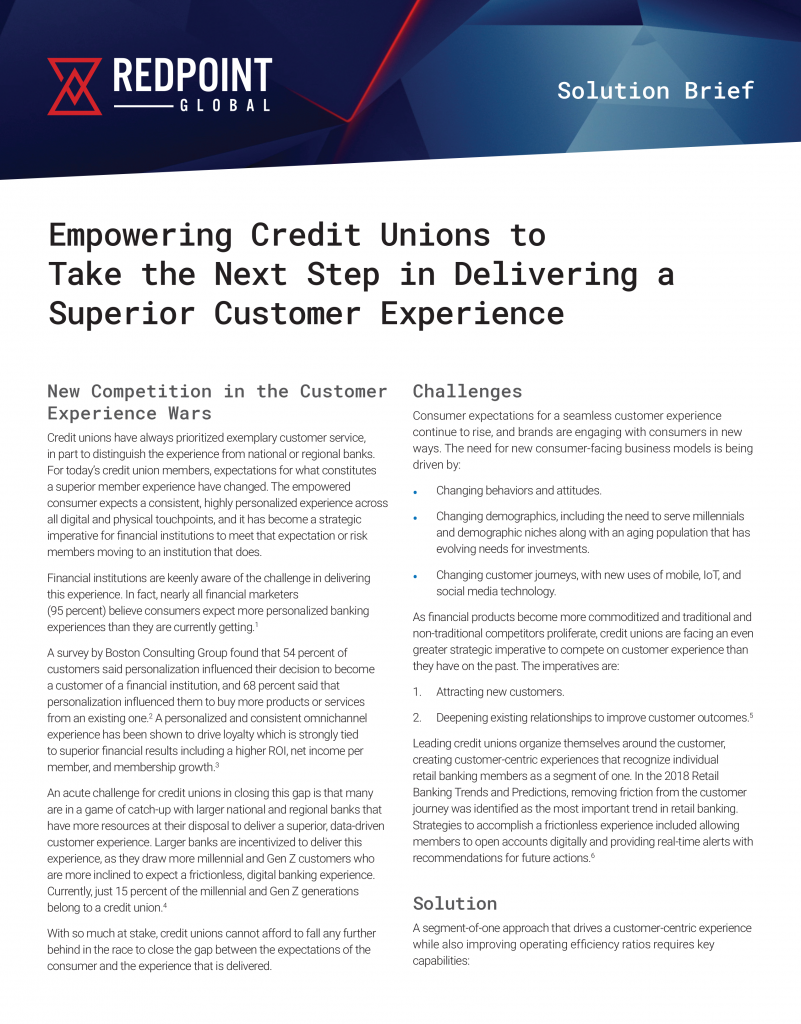 Credit unions face an uphill battle to attract millennials, the roughly 80 million Americans born between 1981 and 1996 whose youngest members are now mostly out of school and on their own, launching careers, and beginning to think about long-term financial security.
Credit unions face an uphill battle to attract millennials, the roughly 80 million Americans born between 1981 and 1996 whose youngest members are now mostly out of school and on their own, launching careers, and beginning to think about long-term financial security.
As a recent Credit Union Journal survey makes clear, simply educating millennials on the merits of credit unions is a pressing concern. According to the survey polling more than 500 millennials, when asked to describe a credit union, 45 percent said they “offer a more human, less digital experience”, while 31 percent said they were “small banks with limited offerings”. Worst of all for credit union marketing teams, 25 percent of millennials fessed up to having “no idea how to describe one.”
It is imperative that credit unions overcome this challenge to replace an aging customer base, with half of all credit union members now 53 or over. With only 24 percent of millennials currently belonging to a credit union, the silver lining is that there is plenty of runway to attract new customers. There is more good news for credit unions that do solve the education problem; millennials value many of the experiences and services that credit unions are traditionally known for, including a personalized customer experience, a community-based ethos, and exemplary service.
Large banks rate poorly on delivering some of these valued services, giving credit unions another opening to attract younger customers with a differentiated experience. Consider the 2019 Digital Banking Report, where 94 percent of financial institutions rated themselves as unable to deliver on the “personalization promise” that customers expect.
Ample opportunity exists for credit unions to attract millennials by addressing the customer experience gap and providing localized service that larger banks can’t match. In addition to personalization, the four other issues credit unions need to address are regulations (particularly privacy), community, mobility, and accessibility.
Personalization – Do you know me?
In a survey conducted by Boston Consulting Group, 54 percent of customers said personalization influenced their decision to become a customer of a financial institution, and 68 percent said that personalization influenced them to buy more products or services from an existing one.
Personalization requires knowing everything there is to know about a customer beyond the basics such as banking preferences, and then providing relevant information and offers. As it pertains to the millennial population, personalization could mean knowing how much student loan and overall debt a customer carries, if the customer is looking to buy her first home, or whether she’s started retirement planning. More so than older generations, millennials are looking for financial planning support; offering a personalized experience such as a customized financial plan is one way for a credit union to distinguish itself from the one-size-fits-all approach more likely to be found at a retail bank.
Providing this level of personalization requires that a credit union have a single view of the customer, a persistently updated golden record that includes customer data from a range of sources. An accurate, complete understanding of the customer and their financial situation brings together data from internal applications and systems, and across a range of touchpoints, like mobile apps, payment networks, and social sites.
A single view gives credit unions the ability to organize themselves around the customer to create customer-centric experiences that recognize members as individuals (a “segment of one”), and overcome typical product and channel siloes that introduce friction into the customer experience. Benefits include the flexibility to provide product recommendations at different stages of a customer journey – acquisition, expansion, loyalty, and retention.
Regulation – Can I trust you?
With General Data Protection Regulation (GDPR) and California Privacy Protection Act (CCPA) putting a spotlight on data privacy, the rights of consumers to control how, when, and where their personally identifiable information (PII) and other customer data is used has become a burning issue for every industry.
While financial institutions have always prioritized the protection of customers’ core financial data in conforming to federal and local regulations, new data privacy regulations present credit unions with an opportunity to reconsider the firewall safeguarding personal data, and using it with a customer’s permission to enhance the customer experience. According to a Harris Poll survey commissioned by Redpoint Global, 70 percent of millennials said they are willing to share personal information in return for a more personalized experience, more than GenX (59 percent), Baby Boomers (39 percent), and Seniors (34 percent).
By responding creatively to the privacy mandate, credit unions can create a personalized customer experience matching each customer’s opt-ins and other preferences with the caveat that they are transparent about how they are collecting, storing, and using customer data. The data value exchange is a win-win for the credit union and the customer; the more transparent a credit union is in how the data is used, and the more personalization it offers, the more customers – particularly millennials – are willing to offer personal data.
Community – How do you impact my community?
Attracting millennials by amplifying the community angle is an ace in the hole for credit unions, lending an aura of authenticity that national banks cannot match. According to a Harris Poll study commissioned by Kasasa, nearly half of millennials think it’s important to do business with locally owned businesses, while more than 60 percent said that would consider a credit union if they were changing financial institutions.
Embracing a millennial as a customer and community member requires bringing the online and offline life of the customer together into a demographic, behavioral, and transactional history. By incorporating community-based demographic data into a unified customer profile, marketers can enhance the personalized experience with local flair – such as touting social responsibility programs, local drives, or other community enrichment programs.
Local relevance helps foster loyalty and trust and enriches personalization, giving credit unions an edge over large retail banks. With banking products becoming commoditized, financial institutions are swept up in competing instead on customer experience. According to Capgemini, only 37 percent of banking customers believe their financial institution understand their needs and preferences adequately. Inflecting local knowledge into personalization efforts can be a powerful tool for credit unions to show a level of understanding that larger banks can’t match.
Mobility – Can I bank how and where I want to bank?
As much as millennials value loyalty, trust, and sense of community, one of the more effective ways a credit union can convince millennials to join their ranks is to provide the digital banking options they favor.
According to the 2018 FIS Performance Against Customer Expectations study, millennials rank digital self-service as the most important attribute in their banking relationships – far ahead of trust. The Harris Poll and Kasasa study reports similar findings, with 77 percent of millennials claiming they will only consider financial institutions that offer online banking as well as physical locations, and 65 percent said they’d be more willing to switch to a community bank if it offered a mobile app or mobile check deposit.
Digital self-service extends beyond mobile banking to include avoiding human contact with online and mobile services such as voice banking, account opening, bill pay, and loan origination, and to embrace peer-to-peer payments through integration with apps like Venmo and Zelle.
One challenge for all financial institutions is that many of these channels didn’t exist five or 10 years ago. To provide millennials with the range of digital touchpoints they expect requires marketers to adopt an omnichannel approach. It starts with a single customer view that includes a customer’s physical and digital interactions, preferences, behaviors, and transactions.
Real-time decisioning is the activation layer that unlocks the power of customer data, providing marketers with the ability to personalize the customer experience in the context and cadence of the customer across all touchpoints. For a millennial, this will likely mean engaging with them across the digital channels they prefer, and credit unions must be prepared to deliver this functionality for banking and non-banking activity alike.
Accessibility – Can you accommodate my needs?
Credit unions across the country are facing discrimination lawsuits based on the Americans with Disabilities Act (ADA). Because the non-profit entities are considered “public accommodations” under Title III of the ADA, they are prohibited from “excluding or discriminating against people with disabilities” when conducting business.
Many of the lawsuits allege that credit union websites are or have been “insufficiently accessible” to serve people with disabilities. As these lawsuits move through the courts, credit unions are understandably anxious about the ramifications. Many provide accessibility statements, asking anyone who has difficulty using or accessing any part of the website to contact them, and reiterating their commitment to a “positive experience” for all members. Accessibility is especially important to attract millennials, who according to one study have a higher rate of disabilities than Boomers or Gen-Xers, with roughly 30 percent of working millennials having a disability.
A positive experience may not mean that a person with a disability has the same experience as a person without a disability, but it does mean that they should be able to accomplish all of the same tasks, whether that’s a mobile check deposit, checking a balance online, or transferring funds.
To create the same personalized experience and understanding for a customer with a disability that every other customer enjoys, a credit union must obviously first know about the disability and make sure that it is part of the unified customer profile. More importantly, it must incorporate the customer’s preferences on an individual basis. Voice banking might be a preference for one visually impaired customer, while another may prefer accessibility options for setting up automatic bill pay. Treating all customers with the same disability the same way fails to recognize or engage with the customer as an individual.
Meet Sky-High Expectations, Reach Deep Pockets
One millennials study estimates that by 2020, the largest living generation will have $1.4 trillion in spending power each year. That’s a lot of incentive for credit unions to bring millennials into the fold. The five points we’ve outlined for how a credit union can attract millennials really all boil down to the same important point: treat each millennial as an individual customer. Thinking that all millennials share certain traits and marketing to them as such is a sure-fire way to drive them to another financial institution. While it may seem counter-intuitive, the most effective way to attract millennials is to not think about them as millennials.
RELATED ARTICLES
Personalization in Banking: How Banks Can Do Better by Overcoming Assumptions
Regional Banks and Credit Unions Are Ready to Compete with the Giants
What Should Financial Institutions Look for in a Customer Data Platform?

